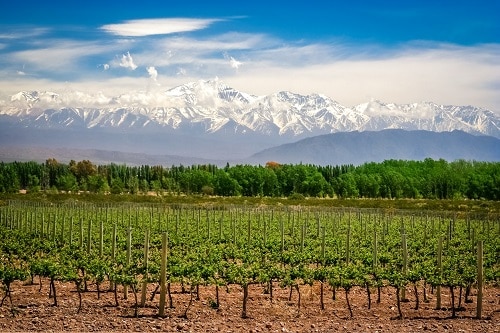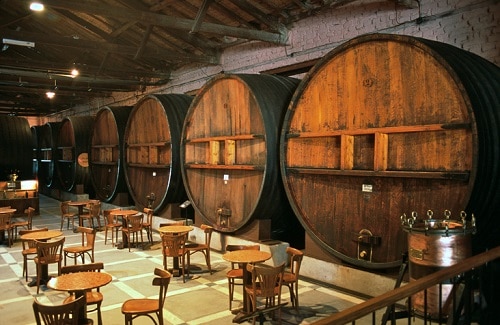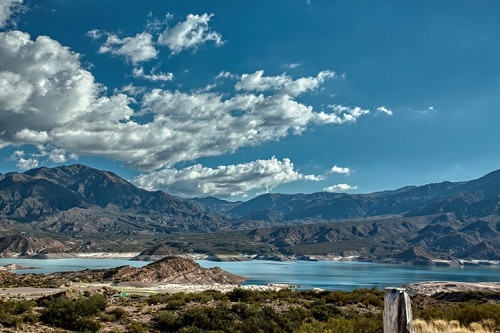Discover Mendoza’s Wine Country
Last Updated on January 14, 2024.
Within the country of Argentina, there are several quality wine regions, but perhaps the most famous and most important is the region of Mendoza, located along the Andes Mountains on the western side of the country. It is in this region where approximately 70% of the wine produced in Argentina is made.
Mendoza is a unique high-altitude region that sees over 300 days of sunlight a year. The soils of the land are rock, sand, and clay and the climate is primarily a dry desert climate situated under the rain shadow of the Andes. Hot days lead to cool nights with little rain for much of the year, providing ideal fluctuations and water stress for grapevines to produce quality fruit.
Most of the vineyards are planted at an average altitude of 900 meters, with some vines growing at heights far exceeding that. The high-altitude viticulture gives the grapes from Mendoza a signature ripeness that creates lush, bold wines in the bottle.
The city of Mendoza is a great place to start a journey tasting through this region, and due to its importance as the main city in a high-volume, high-quality wine-producing region, it has been named one of the Great Wine Capitals in the world and is an extremely popular destination for eno-tourism.
Mendoza’s Grape Varieties
Mendoza is best known for its Malbec wines, which have a deep history in the region. Originally, grapes were brought by the Spanish via Chile in the late 1500s, however, Malbec did not see a significant rise in popularity until much later. It wasn’t until the late 1800s when the Governor of Mendoza asked French agronomist, Miguel Pouget, to bring some vines from France that Malbec became a star in Argentina. The Malbec vines, which are native to Southwest France, adapted quickly to the land in Mendoza and produced a popular wine with richness, rounded tannins, and bold fruit. The style of Malbec made in Argentina is much different than the wines produced in France, with the Argentine version maintaining a bolder more fruit-forward style of wine.
Malbec is not the only grape in Mendoza, Cabernet Sauvignon has also seen great success coming out of this region, as well as Tempranillo, Merlot, Syrah, Bonarda, and Sangiovese for the reds. Chardonnay, Sémillon, Torrontés, Chenin Blanc, Sauvignon Blanc, and Pedro Ximénez are popular white grapes in the region.
Wine Regions within Mendoza
Within Mendoza, there are three main wine growing regions, each with subregions within them.
The Central Region is actually in the northern part of the province with three zones: Alta del Rio Mendoza, East, and North. This area also includes the regions of Luján de Cuyo, which was the first to be recognized as an appellation, and Maipú, just outside the city of Mendoza. The vines in this region are typically planted at 650-1050 meters.
The Uco Valley Region includes the departments of Tupungato, Tunuyán, and San Carlos. Vines here are usually in the highest vineyards at 850-1400 meters.
In the South Region, including San Rafael and General Alvear, vines are planted from 450-800 meters.
RECOMMENDED: These are the Best Wineries to Visit in Mendoza for Wine Tasting
The History of Mendoza
The history of the wine region of Mendoza dates back to the mid-16th century when the Spanish Conquistadors brought grapevines from Europe to the region. The first recorded vineyard was planted in 1551 in Santiago del Estero, a province located in the northern part of the country.
However, it wasn’t until the mid-19th century that the wine industry in Mendoza began to flourish. In 1852, Argentina gained independence from Spain, and a wave of European immigrants, particularly Italians, arrived in the country, bringing with them their viticulture knowledge and techniques.
The development of the wine industry in Mendoza was significantly aided by the construction of a railway line in 1885, which facilitated the transport of grapes and wine to Buenos Aires and other parts of the country. This resulted in a boom in wine production in Mendoza, with many new vineyards being established.
If you’re interested in visiting Mendoza’s stunning landscape and learning more about it’s history, take a look at some of the additional wineries listed on our directory below or on our free mobile wine travel application.
Written By Jacqueline Coleman
Jacqueline Coleman is a professional wine writer, certified sommelier, wine judge and consultant based in Miami, FL.



